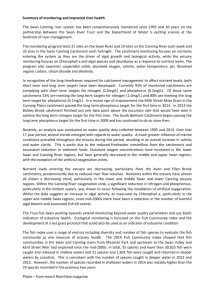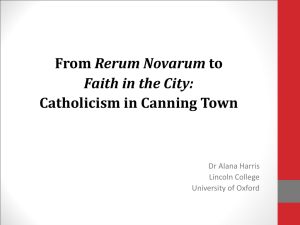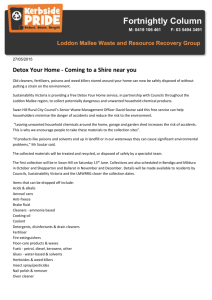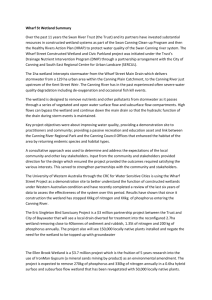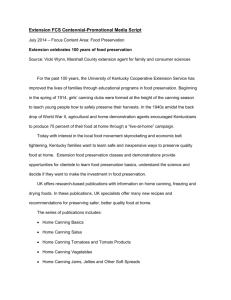Oxygenation program The Swan River Trust and Department of
advertisement
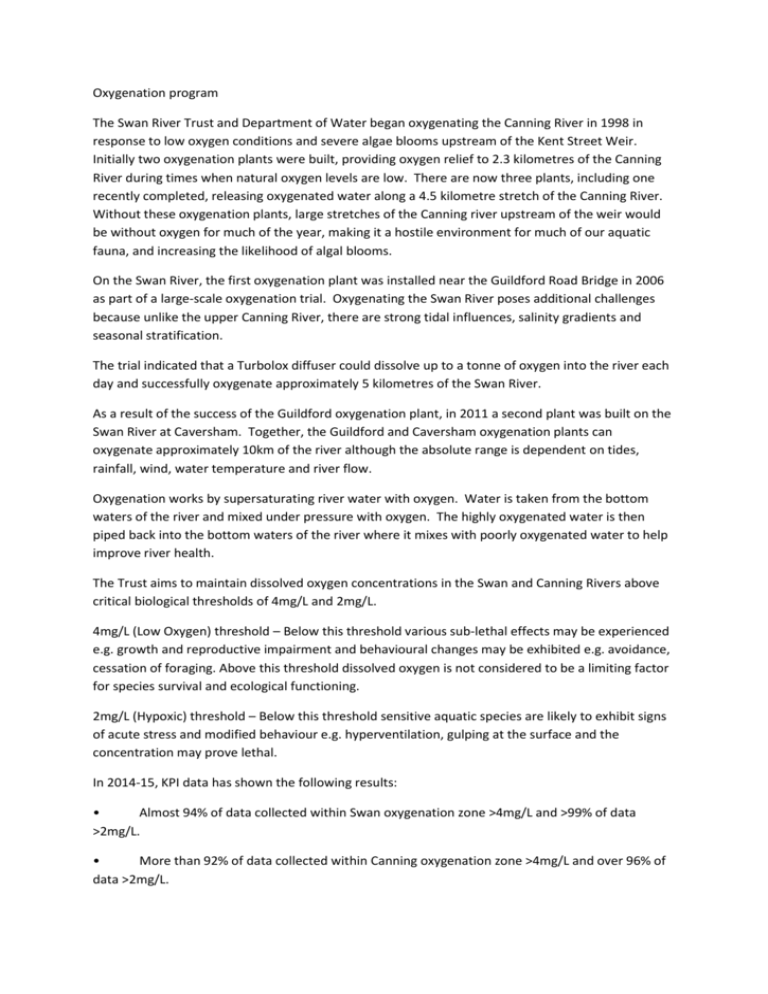
Oxygenation program The Swan River Trust and Department of Water began oxygenating the Canning River in 1998 in response to low oxygen conditions and severe algae blooms upstream of the Kent Street Weir. Initially two oxygenation plants were built, providing oxygen relief to 2.3 kilometres of the Canning River during times when natural oxygen levels are low. There are now three plants, including one recently completed, releasing oxygenated water along a 4.5 kilometre stretch of the Canning River. Without these oxygenation plants, large stretches of the Canning river upstream of the weir would be without oxygen for much of the year, making it a hostile environment for much of our aquatic fauna, and increasing the likelihood of algal blooms. On the Swan River, the first oxygenation plant was installed near the Guildford Road Bridge in 2006 as part of a large-scale oxygenation trial. Oxygenating the Swan River poses additional challenges because unlike the upper Canning River, there are strong tidal influences, salinity gradients and seasonal stratification. The trial indicated that a Turbolox diffuser could dissolve up to a tonne of oxygen into the river each day and successfully oxygenate approximately 5 kilometres of the Swan River. As a result of the success of the Guildford oxygenation plant, in 2011 a second plant was built on the Swan River at Caversham. Together, the Guildford and Caversham oxygenation plants can oxygenate approximately 10km of the river although the absolute range is dependent on tides, rainfall, wind, water temperature and river flow. Oxygenation works by supersaturating river water with oxygen. Water is taken from the bottom waters of the river and mixed under pressure with oxygen. The highly oxygenated water is then piped back into the bottom waters of the river where it mixes with poorly oxygenated water to help improve river health. The Trust aims to maintain dissolved oxygen concentrations in the Swan and Canning Rivers above critical biological thresholds of 4mg/L and 2mg/L. 4mg/L (Low Oxygen) threshold – Below this threshold various sub-lethal effects may be experienced e.g. growth and reproductive impairment and behavioural changes may be exhibited e.g. avoidance, cessation of foraging. Above this threshold dissolved oxygen is not considered to be a limiting factor for species survival and ecological functioning. 2mg/L (Hypoxic) threshold – Below this threshold sensitive aquatic species are likely to exhibit signs of acute stress and modified behaviour e.g. hyperventilation, gulping at the surface and the concentration may prove lethal. In 2014-15, KPI data has shown the following results: • Almost 94% of data collected within Swan oxygenation zone >4mg/L and >99% of data >2mg/L. • More than 92% of data collected within Canning oxygenation zone >4mg/L and over 96% of data >2mg/L. The use of oxygenation technology has become a valuable management tool to ensure that there is enough oxygen for fish and other fauna in the upper reaches of the Swan and Canning Rivers. Can insert map of Oxy plant location and influence if useful Monitoring The comprehensive water quality monitoring program began on the Swan and Canning rivers in 1995 as a partnership between the Swan River Trust and the Department of Water, putting science at the forefront of river management. The estuarine monitoring program tests 21 sites on the Swan River and 19 sites on the Canning River each week, whilst 32 sites are sampled in the Swan Canning Catchment each fortnight. Insert monitoring maps here The catchment monitoring focuses on nutrients entering the system as they are the driver of algal growth and biological activity, while the estuary monitoring focuses on Chlorophyll-a and algal species and abundance as a response to nutrient levels. The program also examines suspended solids, dissolved oxygen, salinity, water temperature, pH, dissolved organic carbon, silicon dioxide and alkalinity. The Swan River Trust employs a world class water quality monitoring program to effectively manage threats to the system and determine changes in ecological condition. Data collected from the water monitoring program allows the Trust, the Department of Water, community groups and riverfront land managers to make informed management decisions based on solid science and enables a proactive response to some of the threats. Long-term, consistent data is invaluable feeding into the management of the river system. The data is used to help guide how the oxygenation plants are operated and how effective the plants are in providing an ecological impact within the oxygenation zone. The data also helps indicate when or where harmful algal blooms are occurring, allowing alerts to be provided to the community and relevant stakeholders. The Swan River Trust publishes this water quality information in a variety of formats on its website. The information is accessible weekly to the public as raw data, reports or easy to understand graphics. It includes vertical plots showing salinity, oxygen content (mg/L and percentage saturation) and water temperature. Insert river profile here The Trust also produces the Microalgae Activity Report which tells the public if there is a low, medium or high algal activity at various sites throughout the Swan Canning estuary. This report is published weekly in the West Australian newspaper. The Trust publishes quarterly water quality reports for both the Swan Canning estuary and catchment that summarise the data collected for that year. Sub-catchment nutrient reports are also available that summarise the nutrient levels entering the system from priority catchments.
